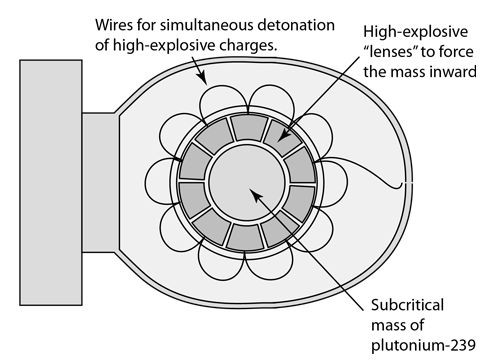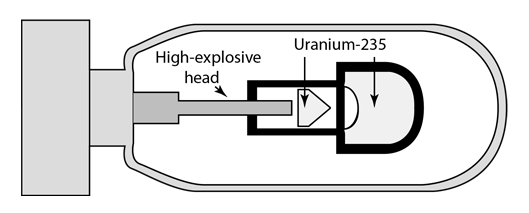Implosion-Type Bomb

| Implosion detonation |
Nuclear weapons concepts
Nuclear energy concepts
Fission concepts
| HyperPhysics***** Nuclear | R Nave |
Implosion-Type Bomb
|
Index Nuclear weapons concepts Nuclear energy concepts Fission concepts | ||
|
Go Back |
Implosion Detonation
|
Index Nuclear weapon concepts Nuclear energy concepts Fission concepts | |||
|
Go Back |
Implosion DetonationOne of the methods for quickly producing a super-critical mass of plutonium for a nuclear explosion is to fashion a sub-critical mass of Pu-239 in a spherical shape and then set off high explosives to drive it inward. A spherical shell of high-explosive material is made up of fitting pieces (called "lenses" to focus the explosion inward) which are wired with detonators to set them off simultaneously. This creates enough force to increase the density of the sphere of plutonium to the point where it is super-critical. This implosion technique was used in the first plutonium bomb test at Alamogordo and in the Nagasaki bomb, each with an explosive power of about 20 kilotons of TNT. The chain reaction lasts about a microsecond. |
Index Nuclear weapon concepts Nuclear energy concepts Fission concepts | ||
|
Go Back |
Gun-Type Nuclear DetonationsWhen one sub-critical mass of a fissile material is held in place and another sub-critical mass is fired into it with the use of high explosives such that the assembly is then super-critical, this is called a gun-type nuclear device. This kind of device was used to construct the Hiroshima bomb. The explosive must force the additional mass into contact so that it maintains contact for about a microsecond, the time it takes for the rapid chain reaction to produce the nuclear explosion. The explosive mass is held in place partly by a heavy, solid surrounding shell called a tamper.  |
Index Nuclear weapon concepts Nuclear energy concepts Fission concepts | ||
|
Go Back |